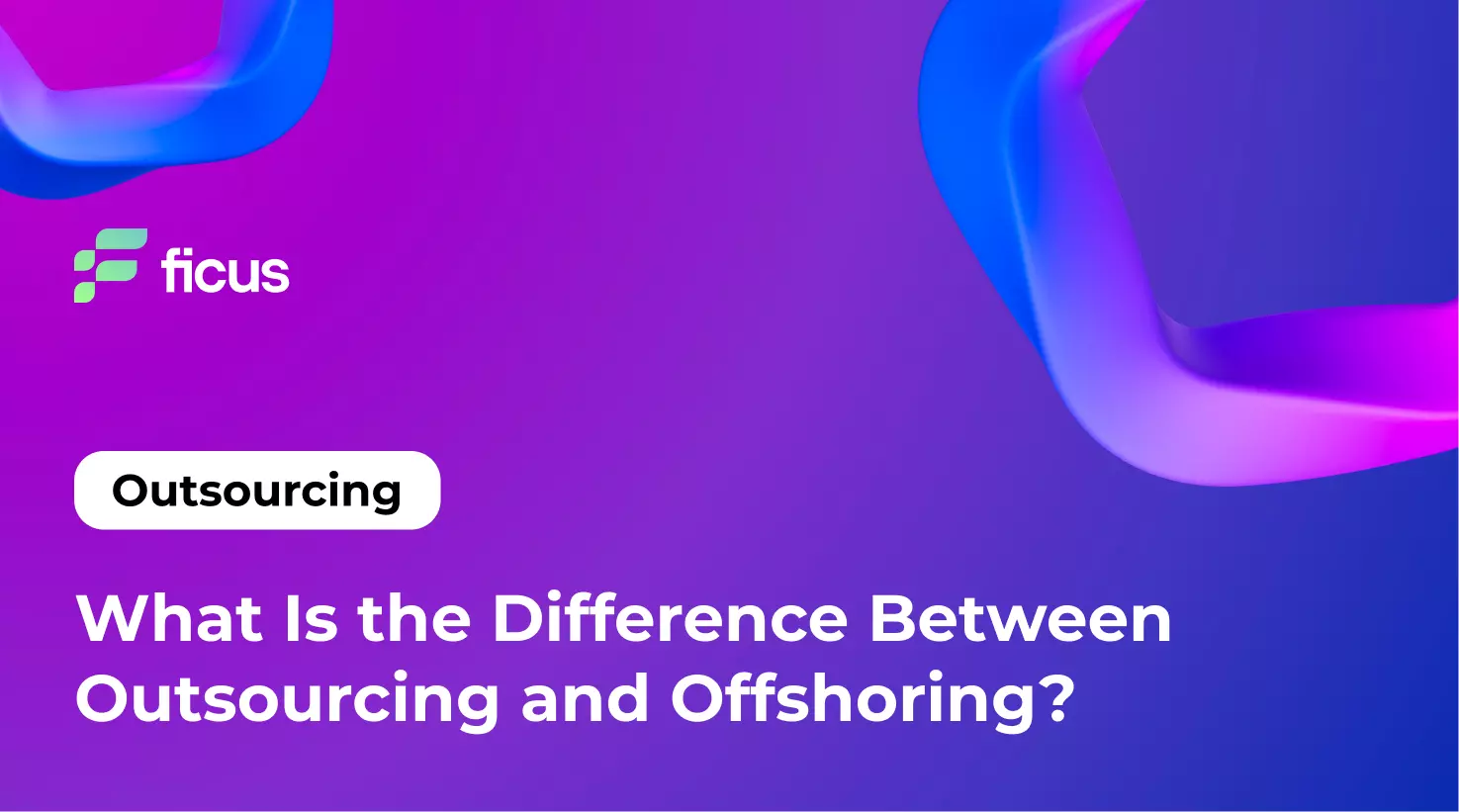The terms offshoring and outsourcing have been part of the business landscape for decades, but understanding the difference between outsourcing and offshoring can be difficult. Outsourcing involves hiring external services to perform tasks that are beyond the company’s capabilities, while offshoring involves having work done outside the home country, often to reduce costs. This article explores the differences between offshoring and outsourcing, providing insight into their respective pros and cons to help you make informed decisions about business strategies.
- Outsourcing focuses on specific tasks; offshoring relocates entire operations for efficiency.
- Management control varies: autonomy in outsourcing and full control in offshoring.
- Consider cost-benefit, cultural nuances, and scalability for strategic decision-making.
What Is Outsourcing?
Outsourcing, a common business strategy, involves delegating non-core activities to external service providers. These specialized organizations perform production, customer service, or payroll tasks. Companies can optimize their operations and focus on their core competencies through effective outsourcing.
Main reasons to outsource:
- Reduced operating costs: The main motivation for companies to outsource is to save money. Whether resolving supplier issues, increasing material costs, or downsizing due to mergers or acquisitions, outsourcing helps companies stay competitive and reduce operating costs.
- Save on training costs: Outsourcing eliminates training costs as part of the overall cost savings. Qualified employees can seamlessly fill positions, eliminating the need for lengthy training and contributing to immediate productivity gains.
- Freeing up resources: Outsourcing allows companies to allocate resources efficiently. As a business expands, additional responsibilities often arise, and outsourcing becomes a viable solution to ensure that experts are available for other projects.
- Company restructuring: Business models may require restructuring, and instead of hiring more experts, companies see outsourcing as a flexible option that provides access to a wider pool of talent.
- Increased productivity and efficiency: Companies looking to improve efficiency often outsource tasks where external expertise can significantly contribute. For example, a laptop company may outsource the production of electronic components to improve overall production efficiency.
- Reducing business risks: Outsourcing certain functions to experienced service providers helps companies reduce financial risks. Leveraging the expertise of outsourced specialists can be a strategic step in risk management.
- Compliance with regulatory requirements: Companies facing compliance requirements may opt for outsourcing teams, relieving existing employees of additional stress. However, control is crucial given the potential risks associated with third-party liability.
- Lower salary requirements: Outsourcing often provides the same services at a lower cost, eliminating the need for companies to hire higher-paid staff.
- Transition to new systems: During the transition to new systems, companies may outsource positions responsible for installation and training. This ensures continuity of business operations during the system change.
- Loss of market share: Companies facing a loss of market share may decide to outsource certain functions, such as sales, to regain competitiveness.
- Specialization of functions and services: Outsourcing specialized functions and services can be more cost-effective. For example, companies can outsource employee cafeteria services or their IT needs to professional service providers.
How Does Outsourcing Work?
Understanding how outsourcing works is critical to understanding the nuances between outsourcing and offshoring. Outsourcing services are typically provided by highly specialized companies specializing in specific processes. The attractiveness of cooperation lies in the outsourcer’s ability to quickly and efficiently cope with the tasks at hand. Contractors often perform tasks for one or more clients simultaneously, with employees remaining on the contractor’s payroll. Outsourcing services are provided based on specialized contracts that stipulate terms, costs, functions, tasks, and other important details, facilitating long-term cooperation and minimizing future disputes.
Why Do Companies Choose Outsourcing?
Outsourcing is a strategic decision for companies that offers benefits beyond cost savings. Well-known companies such as Ford and IKEA use outsourcing to optimize operations by focusing on profit-oriented tasks. The benefits include significant cost savings, improved quality of business processes, reduced risks, increased efficiency of core operations, and a reduction in the number of employees. Outsourcing eliminates resource-intensive internal customizations, saving up to 20-30%, contributing to overall economic efficiency. External contractors, experts in their field, provide effective solutions to specialized tasks, and the contractual focus on results minimizes risks and ensures operational stability for sustainable development.
What Are Examples of Outsourcing?
Let’s dive into real-life examples of outsourcing.
American Express

American Express (AmEx) has long been known for its exceptional customer service strategy. The cornerstone of their approach is empowering customer service representatives to effectively resolve customer issues in a single interaction, underscoring the difference between outsourcing and offshoring. This customer-centric strategy resolves problems quickly and cultivates a sense of value and respect, increasing overall satisfaction and loyalty. AmEx’s unwavering commitment to exceptional service sets a benchmark for the financial services sector, emphasizing the strategic use of outsourcing to achieve customer-centric success.
Apple

Apple is a global leader known for its innovation and sleek design, a philosophy that permeates its products and the entire customer experience. From navigating its website to exploring the App Store or visiting its physical stores, Apple delivers a consistent, intuitive, and visually pleasing experience. The tech giant excels in product design and creating a seamless transition between different devices, illustrating the brand’s commitment to delivering exceptional customer experiences through a combination of innovation and strategic outsourcing strategies.
Starbucks

Starbucks uses technology to enhance the customer experience. The Starbucks mobile app, which is closely linked to the Starbucks Rewards program, allows customers to place orders in advance, customize drinks, earn and redeem rewards, tip baristas, and even determine the songs playing in the store. This desire for personalization and convenience extends to in-store service, where baristas are trained to remember loyal customers and their orders, creating a personalized approach. Starbucks combines innovation, customer focus, and strategic outsourcing to improve overall service and satisfaction.
The important thing about outsourcing or global sourcing is that it becomes a very powerful tool to leverage talent, improve productivity and reduce work cycles.
Peter Drucker
What Is Offshoring?
In today’s business landscape, offshoring has revolutionized traditional employment models. By adopting a more global approach, companies now utilize talent from abroad. A notable example is offshore software development, where teams of experts in remote locations, often in different countries and time zones, collaborate to create software. In addition to the well-known cost savings, access to specialized professionals is a major reason for choosing offshoring. Qualified specialists simplify development processes and contribute to significant cost and time savings.
The main reasons for offshore:
- Cost reduction:
Offshoring is often associated with lower operating costs, making it a financially prudent choice for businesses.
Qualified specialists in offshore centers help reduce costs at various stages of software development.
- Access to professionals and rare experts:
A key advantage of offshoring is the ability to access professionals and rare experts in various fields, increasing software development’s quality and efficiency.
Offshore teams often have highly skilled professionals who can offer unique ideas and solutions to complex problems.
- Global talent pool:
Offshoring allows companies to tap into a vast global talent pool, providing access to skills and expertise that are not always available in local markets.
- Utilizing a global talent pool fosters innovation and creativity in the software development process.
- Difference in time zones:
Offshore development involves collaboration with teams in regions with different time zones, facilitating continuous work cycles.
The difference in time zones ensures round-the-clock productivity, accelerates project delivery times, and reduces time to market.
Diverse geographical opportunities:
Companies can strategically choose offshore locations based on language, cultural compatibility, and proximity to target markets.
For example, Western European companies may choose offshore development to India, while the US may choose Eastern European countries such as Poland or Ukraine.
How Does Offshoring Work?
Offshoring involves strategically relocating a business unit, process, or function to a country where operating costs are more economical. This process is intended to benefit from lower costs without sacrificing efficiency. In the offshoring model, certain business functions are moved to another country while the rest continue to operate in the company’s country of origin. As a rule, companies offshoring hire local labor in the chosen location to perform tasks previously performed by employees in their home country. This approach allows companies to maintain operations while benefiting from cost savings.
Why Do Companies Choose Offshoring?
Selecting an offshore software development company provides businesses with global talent access, fostering innovation and competitive advantages. Beyond securing specific expertise and top-notch deliverables, offshoring streamlines recruitment, enabling rapid idea realization. Specialized teams, unique tech stacks, and faster concept implementation contribute to accelerated development. The flexibility to scale dynamically based on project needs minimizes costs and recruitment delays. Trusted offshore partners share responsibilities, ensuring quality, risk mitigation, and a smoother product operation. Ultimately, offshoring expedites development cycles, reducing time to market in the competitive business landscape.
What Are Examples of Offshoring?
The following are prosperous instances of businesses that have offshoring services:

WhatsApp, acquired by Facebook for $19 billion in 2014, has been extremely successful, with a minimum staff of 55. Despite its small team, the messaging app had more than 450 million monthly active users worldwide. A key factor behind WhatsApp’s rapid growth has been the effective use of offshore talent. Having assembled development teams in Eastern Europe, the company has taken top positions on major platforms such as Google Play and the App Store. This offshore strategy has fueled WhatsApp’s unprecedented growth, cementing its position as a valuable asset within Facebook’s larger portfolio.

Despite boasting one of the largest in-house development teams in the world, Google recognizes the value of outside perspectives for true innovation. A 2018 Bloomberg report found that Google’s contractors outnumbered full-time employees, demonstrating the company’s commitment to diverse talent. In 2020, Google moved significantly by acquiring CloudSimple, a Ukrainian company specializing in secure and high-performance VMware migration solutions. This strategic offshoring decision strengthened Google’s cloud services, highlighting the importance of leveraging global expertise to remain dynamic and relevant in today’s fast-paced business environment.
IBM

IBM, a global technology powerhouse with operations in more than 170 countries, has been an offshoring innovator since the 1960s. Its historic offshoring of production laid the groundwork for continued offshoring initiatives. IBM strategically uses offshoring for software development, consulting services, research and development, and cloud monitoring. With a large workforce, IBM ranks as the largest multinational employer in India, reflecting its commitment to the country’s development through significant investment in infrastructure, the economy, and advanced technology labs.
Are you looking for outsourced staff for your project?
Contact UsKey Differences Between Outsourcing and Offshoring
Understanding the differences between outsourcing and offshoring is essential to making informed business choices. Understanding the ins and outs of offshoring versus outsourcing helps in strategic decision-making. The difference between outsourcing and offshoring affects global business strategies.
Job: Nature of Work
When distinguishing between outsourcing and offshoring, it is important to recognize their inherent differences. Outsourcing involves delegating specific tasks to an external provider, while offshoring moves all operations to another location. For example, outsourcing customer service tasks to the Philippines is an example of a task-specific approach, while offshoring involves setting up a comprehensive call center in the same country.
Management: Duties and Responsibilities
An important factor in understanding the difference between outsourcing and offshoring is the level of management required. Through outsourcing, companies give external partners the autonomy to perform certain functions while maintaining communication and collaboration. In contrast, offshoring requires full control over operations, including oversight of people, processes, and infrastructure to ensure smooth operations.
Cost: Savings Benefit
When deciphering the difference between outsourcing and offshoring, the cost-benefit is the determining factor. Offshore outsourcing proves cost-effective for short-term projects, potentially cutting labor costs by up to 70%. However, ground outsourcing may not prioritize immediate cost reductions. In contrast, offshoring offers a long-term solution for significant cost reductions covering both labor and operational costs.
People: Employees vs. Non-employees
Studying the workforce is vital to understanding the difference between outsourcing and offshoring. In outsourcing, the individuals performing the tasks are not direct employees but are contracted to the BPO service provider. Conversely, offshoring involves hiring individuals directly as part of the company’s workforce. This difference means that outsourcing does not require direct investment in people, while offshoring involves building relationships and investing in new teams of employees.
Technology: Technological Investments
Another key difference between outsourcing and offshoring is technology investment. Outsourcing usually does not require direct investment in digital tools, as the BPO provider usually has the necessary resources. In contrast, offshoring requires a significant investment in modern technology, as the company is responsible for deploying, maintaining, and updating systems to ensure uninterrupted operations.
Infrastructure: Facility Establishment
The concept of “infrastructure” clearly indicates the essential differences between outsourcing and offshoring. When outsourcing, businesses do not need to worry about infrastructure, as the hired provider already has the premises and resources to operate. However, offshoring requires finding a suitable location, setting up the infrastructure, and familiarizing yourself with the legal and regulatory requirements for opening an office in the chosen country.
Culture: Cultural Differences
Cultural differences become a decisive factor in the difference between outsourcing and offshoring. While cultural differences may not be a major concern in onshore outsourcing, offshoring requires an openness to diverse cultures. Starting a business in another country requires understanding and adapting to its cultural nuances, traditions, practices, and even holidays, especially in places like the Philippines for customer service outsourcing.
Geographical Distance: Time Zone Differences
Geographic distance and time zone differences highlight another key difference between outsourcing and offshoring. Time zone differences can affect collaboration and operations, and onshore outsourcing will have minimal impact. However, offshoring requires careful consideration of time zone differences. Strategies such as flexible scheduling become necessary to serve customers on the opposite side of the globe.
Scalability: Long- or Short-term Investment
Scalability is key to business growth, influencing the choice between outsourcing and offshoring. Outsourcing optimizes processes in the short term by providing access to expertise and technology to optimize operations. Conversely, offshoring is ideal for long-term scalability, enabling global expansion, wider market reach, and increased competitiveness.
Risks: Potential Challenges
Both outsourcing and offshoring have inherent advantages and disadvantages, requiring a thorough understanding of the potential challenges. Outsourcing creates challenges such as managing cultural differences, bridging communication gaps, and maintaining control. At the same time, offshoring is associated with higher risks and requires due diligence in studying the market, legislation compliance, and local regulations. A successful implementation offers a variety of benefits, including significant cost savings and global expansion opportunities.
How To Choose Between Outsourcing and Offshoring?
When faced with the decision of outsourcing vs offshoring, careful consideration of business strategy and objectives is imperative. Both models involve the involvement of remote teams in tasks that have common features but have differences. The choice between them depends on a comprehensive analysis of the business niche, requirements, and goals. Recognize the potential risks of working with third parties, emphasizing detailed contracts. Despite public opinion, business owners often look to offshoring vs. outsourcing as viable growth solutions, recognizing that not all tasks can be done in-house. The decision-making process requires careful evaluation before making a final choice.
Final Thoughts
Understanding the difference between outsourcing and offshoring is paramount to strategic decision-making in a dynamic business landscape. While outsourcing involves delegating specific tasks to external service providers, offshoring takes a broader approach by moving all operations to different locations. These strategies influence managerial control, cost savings, cultural nuances, and scalability. Companies must carefully weigh the pros and cons, considering factors such as cost-effectiveness, workforce management, and global expansion goals, to choose a model that meets their unique needs.
Understanding the intricacies of outsourcing vs. offshoring, Ficus Technologies has become a reliable partner. With a proven software development and IT recruitment track record, Ficus helps companies bring ideas to life worldwide. This flexible pipeline, adapted to customers’ needs, ensures the business achieves its goals efficiently and effectively.
Yes, it is possible to offshore without outsourcing, although the terms are often used together. Offshoring refers to relocating business processes or functions to another country to benefit from cost advantages, global talent, or other strategic reasons. On the other hand, outsourcing involves contracting tasks or services to external providers, which may or may not be in another country. So, while offshoring often involves outsourcing certain functions, a company can establish its own offshore operations without relying on external vendors by directly hiring and managing a team in the chosen offshore location.u003cbru003e
Yes, outsourcing can indeed be done internationally. In fact, international outsourcing is a common practice where companies hire external service providers located in different countries to perform specific tasks or functions. This global approach allows businesses to tap into a diverse talent pool, take advantage of cost efficiencies, and access specialized skills not readily available in their home country. Many companies engage in international outsourcing to streamline operations, enhance efficiency, and focus on their core competencies while leveraging the expertise and resources of service providers from around the world. It is a strategic business practice that fosters collaboration on a global scale.








